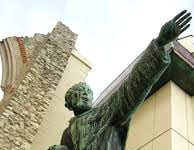Learn about the origin and evolution of the telescope, from its invention in the 17th century to modern advancements, and how it transformed our understanding of the universe.
The Origin and Evolution of Telescope
A telescope is an optical instrument that is designed to gather and focus light from distant objects. The main function of a telescope is to make faraway objects appear closer and clearer than they would appear to the naked eye. Telescopes come in different shapes and sizes, but they all have two basic components: an objective lens or mirror that gathers the light, and an eyepiece or camera that magnifies the image.
Telescopes can be used for a variety of purposes, including astronomy, birdwatching, surveillance, and even hunting. In astronomy, telescopes are used to observe and study celestial objects such as stars, planets, galaxies, and nebulae. There are different types of telescopes, including refracting telescopes, reflecting telescopes, and catadioptric telescopes, each with its own advantages and disadvantages.
In this essay, we will explore the origin and evolution of the telescope, from its earliest beginnings to its modern-day applications.
The history of the telescope can be traced back to the early 17th century, when two men, Hans Lippershey and Zacharias Janssen, are said to have independently invented the device. They were both Dutch spectacle-makers, and it is believed that they used their knowledge of lenses to create a device that could magnify distant objects. In 1608, they presented their invention to the States General of the Netherlands, who were impressed by its potential and granted them a patent.
The first telescopes were relatively simple devices, consisting of a convex objective lens and a concave eyepiece. They were often only a few inches long, and their magnification was limited to a few times the naked eye. Nevertheless, they were a vast improvement over the naked eye, and they soon caught the attention of astronomers.
One of the first astronomers to use a telescope was Galileo Galilei. In 1609, he heard about the device and set about building his own. He quickly discovered that the telescope allowed him to see things that were invisible to the naked eye, such as the moons of Jupiter and the phases of Venus. These observations challenged the prevailing view of the cosmos, which held that the Earth was at the center of the universe. Galileo’s discoveries provided evidence for the heliocentric model of the solar system, which placed the Sun at the center and the Earth and other planets in orbit around it.
Over the next few decades, the telescope underwent a number of improvements. Astronomers began to experiment with different lens shapes and sizes, as well as different materials for the lenses. They also discovered that adding a second convex lens to the device could increase its magnification even further. These improvements allowed astronomers to see even more distant and faint objects in the night sky.
In the 18th and 19th centuries, the telescope underwent another transformation. Telescope makers began to use mirrors instead of lenses to focus light. This led to the development of the reflecting telescope, which had a much larger aperture than the refracting telescope and could gather more light. Reflecting telescopes also eliminated the problem of chromatic aberration, which had plagued refracting telescopes. The most famous example of a reflecting telescope is the Hubble Space Telescope, which was launched into orbit in 1990.
Today, the telescope is used for a wide range of applications, from astronomical research to surveillance and military reconnaissance. The development of digital imaging technology has allowed astronomers to capture images of distant objects with unprecedented clarity and detail. Telescopes have also been used to study the properties of exoplanets, which are planets outside our solar system. In recent years, the discovery of numerous exoplanets has sparked renewed interest in the search for extraterrestrial life.
In conclusion, the telescope has come a long way since its humble beginnings in the early 17th century. From a simple device that could magnify distant objects a few times, it has evolved into a powerful tool that can reveal the secrets of the cosmos. The telescope has revolutionized our understanding of the universe and has provided us with a window into the mysteries of space. Its continued development and use promise to reveal even more of the universe’s secrets in the years to come. 0 0 0
The Origin and Evolution of Telescope: FAQs
1. What is a telescope?
A telescope is an optical instrument designed to observe distant objects by collecting and magnifying light. It allows astronomers and observers to see celestial bodies, such as stars, planets, and galaxies, that are otherwise invisible to the naked eye.
2. Who invented the telescope?
The invention of the telescope is credited to Dutch eyeglass maker Hans Lippershey in 1608. However, Galileo Galilei was the first to use a telescope for astronomical observations in 1609, significantly enhancing its design and capabilities.
3. How did the first telescopes work?
The earliest telescopes were refracting telescopes, which used lenses to bend (refract) light to form an image. Lippershey’s and Galileo’s designs consisted of a convex objective lens and a concave eyepiece lens to magnify distant objects.
4. What were Galileo’s contributions to the development of the telescope?
Galileo improved the design of the telescope by increasing its magnification power, which allowed him to make groundbreaking astronomical discoveries. He observed the moons of Jupiter, the phases of Venus, sunspots, and the rugged surface of the Moon, challenging the prevailing geocentric view of the universe.
5. How did the telescope evolve after Galileo’s time?
In 1668, Isaac Newton developed the first reflecting telescope, which used mirrors instead of lenses to collect and focus light. This design, known as the Newtonian telescope, overcame chromatic aberration (color distortion) that plagued refracting telescopes.
6. What are the main types of telescopes used today?
The three main types of telescopes are refracting telescopes (which use lenses), reflecting telescopes (which use mirrors), and compound (or catadioptric) telescopes, which combine lenses and mirrors. Modern telescopes also include radio, infrared, and space telescopes like the Hubble Space Telescope.
7. What is the significance of the Hubble Space Telescope?
Launched in 1990, the Hubble Space Telescope orbits the Earth and provides unprecedented views of the universe, free from atmospheric distortion. It has made numerous discoveries, including determining the rate of expansion of the universe and capturing detailed images of distant galaxies and nebulae.
8. How has the telescope impacted our understanding of the universe?
Telescopes have revolutionized our understanding of the universe by allowing us to observe distant stars, galaxies, and other celestial phenomena. They have enabled discoveries such as the existence of other galaxies, the expansion of the universe, and the detection of exoplanets.
9. What are some recent advancements in telescope technology?
Recent advancements include adaptive optics, which corrects for atmospheric distortion in ground-based telescopes, and the development of large space telescopes like the James Webb Space Telescope. These technologies allow for clearer, more detailed observations across various wavelengths of light.
10. What is the future of telescope technology?
The future of telescopes includes the development of even larger ground-based telescopes, such as the Extremely Large Telescope (ELT) and space-based observatories that will observe in new wavelengths, like the James Webb Space Telescope, which will explore the infrared spectrum to see the earliest galaxies.
These FAQs provide a comprehensive overview of the history, development, and impact of the telescope. 0 0 0
The Origin and Evolution of Telescope: Facts
Here is a set of key facts about the origin and evolution of the telescope:
- Early Invention: The first telescope was invented in 1608 by Hans Lippershey, a Dutch eyeglass maker. His design used lenses to magnify distant objects, and though simple, it marked the beginning of telescopic astronomy.
- Galileo’s Contributions: Galileo Galilei improved the basic design of the telescope in 1609, increasing its magnification power significantly. He was the first to use a telescope for astronomical observations, discovering the moons of Jupiter, the phases of Venus, sunspots, and the rugged terrain of the Moon.
- The Refracting Telescope: Early telescopes, including Galileo’s, were refracting telescopes that used lenses to bend light. These telescopes were limited by chromatic aberration, a distortion of colors that occurs when different wavelengths of light refract by different amounts.
- Introduction of the Reflecting Telescope: In 1668, Isaac Newton developed the first reflecting telescope, which used a curved mirror to reflect and focus light. This design eliminated chromatic aberration and allowed for larger telescopes, significantly advancing astronomical observation.
- The Achromatic Lens: The achromatic lens, invented in the 18th century, was a major advancement for refracting telescopes. It combined two types of glass to reduce chromatic aberration, improving the clarity of images.
- Advancements in the 19th and 20th Centuries: The 19th century saw the creation of large refractors, like the Great Refractor at the Lick Observatory. In the 20th century, reflecting telescopes became dominant, with the 100-inch Hooker Telescope at Mount Wilson Observatory being instrumental in Edwin Hubble’s discovery of the expanding universe.
- Space Telescopes: The Hubble Space Telescope, launched in 1990, revolutionized astronomy by providing clear images of space without atmospheric distortion. It has contributed to major discoveries, such as determining the rate of expansion of the universe and the observation of distant galaxies.
- Modern Technologies: Modern telescopes use advanced technologies such as adaptive optics, which corrects for atmospheric distortions in real-time, and interferometry, which combines data from multiple telescopes to create higher-resolution images.
- The James Webb Space Telescope: Set to succeed Hubble, the James Webb Space Telescope (launched in 2021) is designed to observe the universe in infrared, allowing astronomers to see through cosmic dust clouds and observe the formation of the earliest galaxies.
- Future of Telescopes: The future of telescopes includes the construction of extremely large ground-based telescopes, like the Extremely Large Telescope (ELT) in Chile, which will have a 39-meter primary mirror. These telescopes aim to further explore the universe, search for exoplanets, and study the potential for life beyond Earth.
These facts outline the key developments in the history of the telescope, from its early invention to its impact on modern astronomy. 0 0 0
List of Noteworthy Telescopes
1. Galileo’s Telescope (1609)
- Type: Refracting Telescope
- Significance: First telescope used for detailed astronomical observations; led to discoveries of Jupiter’s moons, the phases of Venus, and more.
2. Newton’s Reflecting Telescope (1668)
- Type: Reflecting Telescope
- Significance: First practical reflecting telescope, invented by Isaac Newton; eliminated chromatic aberration, allowing clearer observations.
3. Herschel’s 40-Foot Telescope (1789)
- Type: Reflecting Telescope
- Significance: Built by William Herschel, it was the largest telescope of its time and used to discover moons of Saturn and other deep-sky objects.
4. Great Refractor at Harvard Observatory (1847)
- Type: Refracting Telescope
- Significance: One of the largest refracting telescopes of its time, it contributed significantly to stellar photography and the study of variable stars.
5. Yerkes Observatory 40-inch Refractor (1897)
- Type: Refracting Telescope
- Significance: The largest refracting telescope ever built, it was instrumental in early studies of the atmosphere of planets and other celestial observations.
6. 100-inch Hooker Telescope at Mount Wilson Observatory (1917)
- Type: Reflecting Telescope
- Significance: Used by Edwin Hubble to discover the expansion of the universe, leading to the formulation of Hubble’s Law.
7. Palomar Observatory’s Hale Telescope (1948)
- Type: Reflecting Telescope (200-inch)
- Significance: The largest optical telescope in the world for many years; contributed to numerous discoveries, including quasars and the structure of galaxies.
8. Arecibo Observatory (1963)
- Type: Radio Telescope
- Significance: Famous for its role in the search for extraterrestrial intelligence (SETI), mapping asteroids, and making significant radio astronomy observations. It was the world’s largest single-aperture radio telescope until 2016.
9. Hubble Space Telescope (1990)
- Type: Space-based Reflecting Telescope
- Significance: Provided unprecedented deep-space images free from atmospheric distortion; contributed to the discovery of the accelerating expansion of the universe, among many other findings.
10. Very Large Telescope (VLT) at Paranal Observatory (1998)
- Type: Array of Reflecting Telescopes
- Significance: Located in Chile, VLT consists of four telescopes that can operate individually or together for higher resolution. It has been key in the study of exoplanets, black holes, and distant galaxies.
11. ALMA (Atacama Large Millimeter/submillimeter Array) (2011)
- Type: Radio Telescope Array
- Significance: Located in Chile, ALMA is one of the most powerful radio observatories, used to study star formation, distant galaxies, and the cosmic microwave background.
12. James Webb Space Telescope (2021)
- Type: Space-based Infrared Telescope
- Significance: Designed to succeed Hubble, it observes the universe in infrared, allowing astronomers to see the earliest galaxies, star formation, and the atmospheres of exoplanets.
13. Extremely Large Telescope (ELT) (Expected 2027)
- Type: Ground-based Reflecting Telescope
- Significance: Located in Chile, it will be the world’s largest optical/near-infrared telescope, with a 39-meter mirror, aiming to explore the first galaxies and potentially habitable exoplanets.
These telescopes have played pivotal roles in advancing our understanding of the universe, each contributing unique capabilities and insights into the cosmos. 0 0 0
Synonyms or Related Terms for ‘Telescope’
1. Spyglass: A small, handheld telescope, typically used for terrestrial observations. It is often associated with sailors and pirates from the past, who used it to spot distant ships or land. Spyglasses are simple refracting telescopes with a compact design.
2. Scope: A casual and abbreviated form of “telescope.” The term is commonly used in various contexts, such as rifle scopes or spotting scopes, which are specialized telescopes designed for specific tasks like aiming or wildlife observation.
3. Optical Tube: Refers to the main body of a telescope that contains the lenses or mirrors. The optical tube is a critical component that directs and focuses light. This term is used in technical contexts, especially when distinguishing the telescope’s body from its mounting and other accessories.
4. Binoculars: A pair of telescopes mounted side-by-side and aligned to point in the same direction, allowing use with both eyes. While not a direct synonym, binoculars serve a similar purpose as telescopes for viewing distant objects, especially on Earth, such as in birdwatching, sports, or stargazing.
5. Observatory Instrument: A broad term used to describe large telescopes and other devices housed in observatories for astronomical research. These instruments are typically more sophisticated and powerful than personal telescopes, designed for scientific observation and data collection.
6. Refractor: A type of telescope that uses lenses to gather light and form an image. Refractors were the first type of telescope invented and are known for their simplicity and high-quality images, especially for observing planets and the Moon.
7. Reflector: A type of telescope that uses mirrors instead of lenses to collect and focus light. Reflecting telescopes are popular in both amateur and professional astronomy due to their ability to handle larger apertures without the issues of chromatic aberration seen in refractors.
8. Magnifier: A general term that describes any device that enlarges the appearance of objects, including telescopes, microscopes, and magnifying glasses. While broader than the term “telescope,” it encompasses the primary function of telescopes as tools for magnifying distant objects.
9. Optical Instrument: A general category that includes any device that aids in viewing or examining objects through the manipulation of light. Telescopes, microscopes, cameras, and binoculars all fall under this term. It highlights the scientific and observational functions of telescopes.
10. Scope Viewer: An informal term for any device that allows viewing of distant objects. This term is often used in casual conversation and can refer to telescopes, binoculars, or other similar devices designed to bring distant scenes closer to the observer.
These notes provide a concise explanation of each term, highlighting how they relate to or differ from the concept of a telescope. 0 0 0
You May Like:
N.B. The article originally belongs to the book ‘Essays on Science And Technology‘ by Menonim Menonimus.
The Origin and Evolution of Telescope
Books of Composition by M. Menonimus:
- Advertisement Writing
- Amplification Writing
- Note Making
- Paragraph Writing
- Notice Writing
- Passage Comprehension
- The Art of Poster Writing
- The Art of Letter Writing
- Report Writing
- Story Writing
- Substance Writing
- School Essays Part-I
- School Essays Part-II
- School English Grammar Part-I
- School English Grammar Part-II..
Related Search:
- The First Telescopes
- A Brief History of the Telescope
- Atomic Bomb
- The Story of the Atomic Bomb








